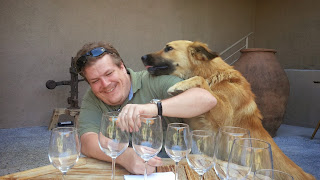tirsdag 10. desember 2013
Casablanca - the wine valley of Chile
When South America was first explored by the Conquistadores of Europe, the prime goal was to make more money for kings and queens of the old world. One way to make money is by producing good wine, and thus explorers were dispatched to the newly conquered southern lands of South America to look for locations where such business could be successfully conducted. These quests ended up in the discovery of Casablanca Valley - now one of the more known locations for production of, especially, cold climate wine.
We booked this trip following a recommendation by our landlord in Valparaiso. His friend, Englishman Michael Ayandokun, runs Valparaiso Wine Tours (www.winetoursvalparaiso.com), and proved to be an excellent and knowledgeable host.
First he took us to Casas Del Bosque. A relatively new wineyard, but one that already has claimed several international prizes - amongst them "The worlds best red wine". We got a tour of the estate, including an in-depth explanation on the difficulties with growing grapes in Casablanca Valley. There is no running water there for once, so wells have to be dug to ensure growth of the crop. Another thing is the climate that reaches as far down as the freezing point. The way to overcome this is to have huge turbines set up all over the fields to constantly move the air, preventing temperatures from going to low. Sounds like a lot of work? Well, they manage to make a profit all the 13 producers operating out of Casablanca.
Our second stop was with Emiliana Organic. They pride themselves on being the only certified biodynamic wine producer of the Valley. What they do different from the competition is that they try make the environment as natural as possible for the grapes to grow. One thing is having a trolley with chickens that they move around the fields during the day. Another thing is they grow flowers between the wine ranks, making the latter "battle" the flowers for the nutrition in the ground. They also have Llamas, ladybugs, and several other things present in the field, making a trip around the premises quite enjoyable - and something very different.
Another, more questionable thing they do is they use the "powers" of the earth, the moon and the stars with charms and astrology claiming to have impact on the growing grapes. Any effect? Well, the wine they produce is pretty decent but I cannot say the "biodynamic" one was much more different than the "organic" one. Interesting experience though!
Lunch were had in a local restaurant, Macerado, placed in the middle of the valley and consisted of seafood, an incredible tasty main course with potatoes and pork ribs, and a ridiculous dessert platter. If there is anything I regret about this trip in total is the amount of food consumed during the four weeks. I think I gained in the area of 10-15 pounds - and this just before Christmas where there will be even more food. *sigh* 2014 would be a tough year to get back in shape..
Final visit of the day was at Bodegas RE. Different again from the two previous producers these guys idea is to RE-create and RE-invent the art of making wine. Using clay pots and techniques from biblical times there is little stainless steal to be found around this facility and the results are absolutely on par with today's modern methods. A tour around the bodega is highly recommended - just be advised they have a very friendly dog who eagerly wants to welcome guests. Amongst the three of us, Lars proved to be the favourite:
Being quite the expert on local history Michael told us about the rediscovery of the Carmenere grape. This is a grape that produce red wine, and one that was originally grown in europe. Back in 1863 there was a pest introduced that killed off what was thought to be every piece of Carmenere there was - leaving the Cabernet Sauvignon as this one proved to be immune. Several years later there was some research done on the Chilean Cabernet Sauvignon, revealing that this indeed was NOT what everybody thought it was, but actually the Carmenere. The wine makers were quick to adjust the process for making the wine to better fit the grape - thus reintroducing the Carmenere to the world in 1994 - some 130 years after it first was thought to be extinct. Pretty exciting! And yes, it is also very good. :-)
After touring Casablanca for a whole day, Michael drove us to Santiago International airport, and our final destination Argentina and the Antarctic. Leaving the continent also meant we had to leave things as Internet and cellphone coverage behind, so sadly no room for blogging along the way. We spent the time taking tons of photos though, so stay tuned. Over the weekend I will shed some light on Fin del mundo (the end of the world), and the great white mystical continent to the south - Antarctica.
Abonner på:
Legg inn kommentarer (Atom)






Ingen kommentarer:
Legg inn en kommentar